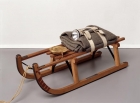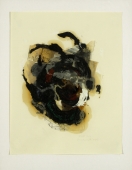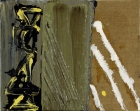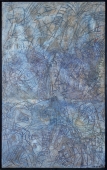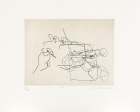
Artist | Joseph Beuys (1921 - 1986)
https://www.artist-info.com/artist/Joseph-Beuys
Biography
Biography
1921 in Krefeld geboren
1964 war Beuys auf der Documenta 3 in Kassei vertreten
1965 hatte er seine erste Ausstellung in einer kommerziellen Galerie (Schmela, Düsseldorf)
1968 Documenta 4, Kassel
1972 Documenta 5, Kassel: Informationsbüro der »Organisation für direkte Demokratie durch Volksabstimmung«
1972 Biennale Venedig: »Straßenbahnhaltestelle«
1977 Documenta 6: »Honigpumpe am Arbeitsplatz«
1982 Documenta 7: Aktion 7000 Eichen
1979/80 Retrospektive im Guggenheim-Museum Now York
1987 Documenta 8: »Blitzschlag mit Lichtschein auf Hirsch«
1986 in Düsseldorf gestorben
About the work (deutsch / english)
About the work (deutsch / english)
Blitzschlag mit Lichtschein auf Hirsch (1958 - 85)
Das Museum für Moderne Kunst zeigt in diesem architektonisch anspruchsvollen Raum eines der letzten großen Environments von Joseph Beuys (1921-1986), das die Stadt Frankfurt 1987 erworben hat. Die Baupläne des Museumsneubaus konnten zu diesem Zeitpunkt entsprechend der benötigten Höhe für den Aufbau des Werks noch modifiziert werden. Als Spätwerk des Künstlers stellt es an diesem Ort eine wichtige Beziehung her zum nahegelegenen Beuys-Block in Darmstadt, der das Hauptwerk der 60er Jahre bildet und der einen Schwerpunkt der ehemaligen Sammlung Ströher dokumentiert.
Der Raum gibt durch die Tageslichtdecke ein gleichmäßiges Licht auf die 39 Elemente umfassende Werkgruppe und unterstreicht damit die skulpturale Qualität der einzelnen Metallobjekte, vor allem ihre nuancierte Farbigkeit. Alle Bestandteile von Blitzschlag mit Lichtschein auf Hirsch gehen zurück auf die "Zeitgeist"-Ausstellung, die im Herbst 1982 im Martin-Gropius-Bau in Berlin stattfand. Beuys hatte dort im zentralen Lichthof ein Werkensemble mit dem Titel Hirschdenkmäler aufgebaut. Es glich zum einen einer Bildhauerwerkstätte, zum anderen dem Arbeitsplatz einer Baustelle. Ein hoher kegelförmiger Berg aus aufgehäuftem braunem Lehm bildete damals das Kernstück, umgeben von zahlreichen Werkbänken, Gerätschaften und einzelstehenden Skulpturen. Durch die zeitlich begrenzte Ausstellung bestand das Werk nur für einen kurzen Zeitraum. Es existiert als solches heute nicht mehr. Beuys entschied sich noch während des Abbaus für eine Konzentration und Reduktion des Werks und ließ nur wenige Teile in Bronze und Aluminium abgießen. Im Vergleich zu den Hirschdenkmälern bildet Blitzschlag mit Lichtschein auf Hirsch durch seine Materialität ein dauerhaftes Monument für die Zukunft.
Der Raumplastik in ihrer heutigen Form ist der Charakter der Werkstatt und des Arbeitsplatzes nach wie vor abzulesen.
Beuys hat zwischen 1983 und 1985 die endgültige Fertigstellung des Werkkomplexes in der Gießerei Noack in Berlin mit größter Sorgfalt betreut und geprüft. Die Oberflächenbeschaffenheit der Bronze war für ihn von großer Wichtigkeit. Sie sollte nach dem Guß, ohne weitere Bearbeitung, ihre natürliche Textur behalten.
Blitzschlag
So entstand die über sechs Meter hohe Keilform mit dem Titel Blitzschlag, die heute als zentrales Element emporragt, durch den Abguß eines Segments des Lehmbergs vom Scheitel bis zur Sohle. Das weiche Material Lehm war zu einer harten metallenen Plastik geworden. "Das Gesamtvolumen des Lehmbergs entsprach übrigens dem von Beuys' eigenem Düsseldorfer Atelier." (Johannes Stüttgen
Bereits bei der ersten Aufstellung des Blitzschlags im November 1985 diente Beuys als Hilfsmittel zur Befestigung des Bronzekeils ein diagonal durch den Raum geführter Eisenträger, an dem die Hängekonstruktion einer Eisenstange das gesamte Gewicht im Gleichgewicht hält. Durch diese Art der Aufhängung berührt die Bronze den Boden nur leicht an einem Punkt.
Beuys hatte diese Präsentation anläßlich der Ausstellung "German Art in the 20th Century" im oktogonalen Kuppelraum der Royal Academy in London noch selbst vorgenommen und mit weiteren, zum Teil früheren Werken aus Bronze und Eisen kombiniert.
Der Blitzschlag erhielt die Frontalität eines überaus plastischen Reliefs. Der dünnwandige Guß wirkt wie die abgestreifte Haut des Lehmbergs, erinnert aber auch an die erkältete Form glühflüssiger Lava, die in einer scharfen Umrißlinie die Gestalt eines Kontinents auf einer Landkarte angenommen hat. In der Kunst des 20. Jahrhunderts läßt eine solche Bronzeplastik unweigerlich an die archetypischen Darstellungen eines Alberto Giacometti denken, dessen Silhouetten der menschlichen Figur das Figur-Raum-Verhältnis in ähnlicher Weise thematisieren. Auch in seinem Werk gab es die Synthese aus konkret Figürlichem und Abstraktem.
Hirsch
Durch Beuys' spezifische Materialauswahl für den Guß des "Hirsches", das silbrig-matt glänzende Aluminium, erhält die Tiergestalt ein Eigenleuchten. Der Hirsch strahlt aus dem übrigen dunkleren Ensemble heraus. "Da steht der Hirsch, und der Hirsch ist ja kein Mensch. Er ist für das gewöhnliche Bewußtsein ein Bestandteil der Natur. Aber wie regiert nun die Natur mit, wenn jede zukünftige Natur eine von Menschen gemachte Natur sein wird?" (Joseph Beuys)
Die stark abstrahierte Form besteht aus den Abgüssen der Segmente eines Ebenholzstammes. Der "Rücken" des Tieres wird aus einem gebrauchten Bügelbrett gebildet. Das Ganze als Figur betrachtet erinnert auch an ein schlittenartiges Vehikel. Der Hirsch als Rudeltier gehört in die kühlere nordeuropäische Landschaft. Bereits im zeichnerischen Frühwerk von Beuys zählt der Hirsch zur häufigsten Gattung seiner Tierdarstellungen. Als zumeist toter Hirsch steht er dort in einem ganz traditionellen kunsthistorischen Bezug zur christlichen Ikonographie.
Das romantisierende deutsche Naturbild kennt den ,majestätischen’ Hirsch als ‘König’ des Waldes, und der ‘Röhrende Hirsch’ in deutschen Wohnzimmern ist nicht von geringer Bedeutung, wenn auch von schlechtem Ruf.
Beuys konfrontiert uns mit einem archaischen Bild des Hirsches, der sich aber durch seinen Glanz und seine plastische Gestalt auf einer viel höheren Stufe der Evolution zu befinden scheint als die Urtiere, die ihn umgeben.
Urtiere
Die 35 "Lehmlinge", amorphe urtierhafte Gestalten, wurden von Beuys ursprünglich aus der Masse des großen Lehmbergs in Berlin von Hand geformt und, einer Partitur vergleichbar, um den Hirsch gruppiert. Den Kern einer jeden Form bilden alltägliche Metallwerkzeuge wie Spachtel, Meißel, Schraubenzieher u.ä. Wie Köpfe ragen die Enden der Werkzeuge aus den Körpern hervor. "Lehm ist Stoff der Erde" (Joseph Beuys). Die Urtiere bilden im gesamten Zusammenhang der Werkgruppe das erste Stadium einer gestalteten Form aus dem Urstoff Erde, aus der bereits frühe Zeichen einer Zivilisation herauskeimen (Werkzeuge). Zudem verkörpern sie das stärkste Bewegungselement im Raum.
Ziege
Ein weiteres Tier in dieser Werkgruppe stellt, wenn auch schwerer nachvollziehbar, die Eisenlore auf drei Rädern dar, auf der der Bronzeabguß einer Spitzhacke aufgestellt ist. Hacke und Stiel bilden dabei den Kopf und die Rückenlinie der Ziege. Die Spitzhacke ist zusätzlich mit Metallbändern auf dem fahrbaren Untersatz befestigt und geerdet. Als bekanntestes Vergleichsbeispiel in der modernen Kunst sei Picassos "Stierschädel" (Tête de taureau) von 1942 genannt, der die berühmteste Umdeutung von Fundstücken darstellt. Picasso hatte den Stierschädel aus dem Ledersattel und der Lenkstange eines Fahrrades gestaltet und anschließend in Bronze abgegossen. Picasso, danach befragt, gab zur Antwort: "Das reicht nicht. Man müßte nur einen Holzscheit nehmen können, auf daß es schon ein Vogel sei.“
Ziege und Hirsch gehören im künstlerischen Arbeitsfeld von Beuys, neben Schwan und Biene, zu den wichtigsten Tieren seines zeichnerischen und plastischen Werks. Hase, Pferd und Coyote waren ‘Mitakteure’ in seinen Aktionen der 60er und 70er Jahre. Es sind allesamt Tiere der nordischen Landschaft, die Beuys' Schaffen in besonderer Weise geprägt hat.
Die Ziege zählt zudem als Haustier zu den ältesten Weggefährten des Menschen. Die Lore ist ein Eisenguß aus dem Zusammenhang von Bergbau und Eisenhüttenwerk. Die Spitzhacke, an der noch Lehmreste haften, stammt aus dem gleichen Arbeitsfeld. Die von Beuys in diesem Werkensemble verwendeten Materialien Bronze, Aluminium und Eisen zählen zu den Bodenschätzen der Erde, die der Mensch aus ihr gewinnt, indem er in sie eindringt. Die Ziege wird bei Beuys zu einem plastischen Bild: "Da steht sozusagen das Tier im Menschen drin ... Das Tier als ein Außenorgan des Menschen, das heißt das Tier gehört zum Menschen. Es ist die Voraussetzung für den Menschen, auch für seine Entwicklung." Beuys spricht gerade in bezug auf die Ziege als Herdentier das Hirtenelement im Menschen an, wenn er sagt: "Der Epimetheus ist der Erhalter der Natur, also der Hirte. Er ist der polare Gegensatz zu Prometheus, dem Vertreter der technischen Evolution." Beuys bezeichnet das naturerhaltende (Ziege/Hirte) und das technische (Bergwerk/Lore) Prinzip als das korrelative System eines ausgewogenen Menschen, der sich seiner Ganzheit bewußt ist. Naturkosmos und Kulturkosmos müssen eine Einheit bilden.
Boothia Felix
Ergänzt wird die Werkgruppe schließlich durch das Objekt mit dem Titel Boothia Felix. Auf einem eisernen dreibeinigen Bildhauer-Modellierfuß ist eine kastenförrnige Bronzeskulptur aufgesetzt. Dabei handelt es sich um den Abguß eines, mit Tonscherben und Wurzelwerk durchsetzten Erdreichs in Form eines ehemaligen Pflanzenbehälters, dessen hölzerne Seitenteile vorher entfernt wurden. Der Boden des Kastens blieb als Sockelfläche erhalten. Es entsteht sozusagen eine Schichtaufnahme des Erdinnern. Auf diesem Bronzeblock hat Beuys einen kleinen Kompaß gelegt. Ein Zeichen für Erdmagnetismus und Orientierung schlechthin. Der Titel der Skulptur bezieht sich auf die geographische Lage der Halbinsel Boothia Felix an der Nordküste Amerikas, in deren Nähe zum Zeitpunkt ihrer Entdeckung, Anfang des 19. Jahrhunderts, der magnetische Nordpol lag. Beim Kompaß zeigt das blaue Nadelende auf den Kältepol im Norden. Er wird zum Richtungselement und als kleinster Bestandteil der Raumplastik eigentlich zum Dreh- und Angelpunkt des ganzen Ensembles.
Boothia Felix markiert den Ort, den der Künstler selbst in der Werkgruppe einnimmt. Auf dem eigentlichen Bildhauersockel, auf dem im traditionellen Sinn ein Torso oder eine Bildnisbüste entstehen müßte, finden wir eine von der Natur und dem Menschen gemeinsam geformte Skulptur.
Boothia Felix und der Blitzschlag, als die beiden vertikalen Elemente im Raum, geben Hinweise auf die elementaren Naturgewalten, die Kräfte und Energien von Himmel und Erde, und auf die Anfänge der Naturwissenschaften und ihre Gesetzmäßigkeiten. Die horizontalen, bodennahen Tiergestalten Hirsch, Urtiere und Ziege beschreiben den Beginn des Evolutionsprozesses der Welt. Eine Schöpfungsgeschichte wird ablesbar, bei der es um das Verhältnis von Natur und Kultur geht.
Kälte und Wärme, Oberhaupt Temperatur, gehören zu den wichtigsten Aspekten im plastischen Werk von Joseph Beuys. Sein anthropologischer Kunstbegriff war der der SOZIALEN SKULPTUR, die jeden Menschen mit einbezieht. Das Monument in seiner heutigen Form ist ein RAUM, "das Museum als Ort der permanenten Konferenz", in dem sich Menschen treffen, um gemeinsam zu arbeiten. "Die Aufgabe der Kunst ist ja, die Bildhaftigkeit des Menschen zu vitalisieren. Erst einmal zu erhalten ... Die Kunst ist nicht dazu da, Dinge zu erklären, sondern die Kunst ist dazu da, die Menschen betroffen zu machen und ihren ganzen Sinnzusammenhang, also ihren Sehsinn, ihren Hörsinn, ihren Gleichgewichtssinn zu aktivieren und zu einem Fähigkeitsprinzip für ihre Arbeit zu machen." (Joseph Beuys)
Die Mitarbeiter des Museums für Moderne Kunst, die den Aufbau der Raumplastik zusammen mit Eva Beuys betreut haben, stellen mit dieser Anordnung ein überaus komplexes Werk von Joseph Beuys zur Diskussion, das er selbst nicht mehr hat aufbauen können und somit ein Fragment bleiben muß.
Text von Mario Kramer, Museum für Moderne Kunst, Frankfurt a.M.
Blitzschlag mit Lichtschein auf Hirsch (Lightning With A Glare on the Stag [1]) (1958 - 85)
The Museum für Moderne Kunst has on show in this monumental room, itself an architectural feat, one of the last great environments by Joseph Beuys (1921-1986), which the city of Frankfurt acquired in 1987. It was still possible at the time, to make suitable modifications to the building plans for the new museum in order for the room to be high enough for the construction of the work. Its location is significant because being one of the artist's late works, it forms an important relation to the nearby Beuys-Block in Darmstadt. The latter is Beuys’s main work of the 1960's and is a core piece of the former Ströher Collection.
The room has a skylight, which sheds an even light on the composite work, made up of 39 elements, and this helps bring out the sculptural quality of the individual metal objects, above all their different tinges of colour. All the components of Blitzschlag mit Lichtschein auf Hirsch (Lightning With A Glare on the Stag) originate from the "Zeitgeist" exhibition, which took place in the autumn of 1982, in the Martin Gropius-Building in Berlin. Beuys had constructed a work ensemble there, in the central courtyard, entitled Hirschdenkmäler (Stag Monuments). It bore resemblance, on the one hand, to a sculptor's studio and on the other, to the workplace of a building site. At the time, a high, cone-shaped mound consisting of a pile of brown clay formed the core of the work. It was surrounded by numerous workbenches, tools and individual sculptures. Due to the exhibition being temporary, the environment only survived for a short period of time. The work itself no longer exists today. While dismantling it, Beuys decided to concentrate on certain elements and to reduce it so that only a few parts were cast in bronze and aluminium. In contrast with the Hirschdenkmäler, Blitzschlag mit Lichtschein auf Hirsch is, due to the type of material from which it has been formed, a permanent monument.
The entire sculpture in its present form continues to resemble a studio and workplace.
Between 1983 and 1985 Beuys supervised and carefully checked the final completion of the complex of works in the Noack Foundry, in Berlin. The nature of the bronze surface was of great importance to him. After being cast, it was to retain its natural texture without further treatment.
Blitzschlag (Lightning
The wedge-shaped object entitled Blitzschlag, over six metres in height from top to bottom, came into being when Beuys cast a segment of the clay mound. The soft clay substance had become a hard metal sculpture. "In fact, the total volume of the mound of clay corresponded to that of Beuys's studio in Düsseldorf." (Johannes Stüttgen)
Already for the first installation of Blitzschlag, in November 1985, Beuys had used an iron girder running diagonally across the room as an aid for securing the bronze wedge. Here, in the Museum für Moderne Kunst, an iron rod hangs down from it to hold the whole weight in balance. This type of suspension ensures that the bronze only touches the floor lightly at one particular point. Beuys had, himself, presented it in this way at the exhibition "German Art in the 20th Century" in the octagonal, domed room of the Royal Academy in London. He had combined the wedge with a number of other works made from bronze and iron, some of which had been created at an earlier date.
Blitzschlag took on the effect of a relief with extreme plasticity. The thin sheet of cast metal might be the skin shed by the clay mound, but it is also reminiscent of hot, flowing lava that has cooled down and taken on the shape of a sharply outlined continent on a map. In the context of 20th century art, this type of bronze sculpture inevitably reminds us of the work of an artist like Alberto Giacometti. His silhouettes of the human figure bore reference to the relationship between figure and space in much the same way. Giacometti’s work also dealt with the synthesis of the figurative and the abstract.
Hirsch (Stag),
Beuys's specific choice of material for casting the Hirsch, namely aluminium, resulted in the figure of the animal obtaining a lustre of its own with its matt silvery gleam. The Hirsch shines out against the darker remainder of the ensemble. "The stag stands there and the stag is not a human being. For the realms of normal consciousness, it is a part of nature. But how will nature continue to have power when every future form of nature will be one made by man?" (Joseph Beuys)
The form, abstract in the extreme, is composed of the casts of pieces of ebony wood cut from a tree trunk. The "back" of the animal has been made from a used ironing board. The figure, viewed as a whole, also suggests a sled-like vehicle. The stag, one of a herd, is associated with the cooler Northern European landscape. It is already a favourite motif in Beuys’s early animal drawings. There, it is mostly the dead stag, which acts as a traditional, art historical reference to Christian iconography. In the romanticized German nature picture, the "majestic" stag is "king" of the forest, and the "bellowing stag", found in German living rooms, is of no less significance, even though its reputation may be questionable.
Beuys confronts us with an archaic image of the stag, which, due to its gleam and its sculptural form, appears to be on a much higher rung of the evolutionary ladder than the Urtiere that surround it.
Urtiere (Primordial Animals)
Beuys originally formed the 35 amorphous, primordial shapes, known as "Lehmlinge" (little clay creatures) by hand from the clay mound in Berlin and he grouped them around the stag as if writing a score. The core of every form is composed of everyday tools like spatulas, chisels, screwdrivers etc. The ends of the tools jut out of the bodies like heads. "Clay is a substance of the earth" (Joseph Beuys). In the whole correlation of the composite work, the Urtiere constitute the first stage of a moulded form made from earth, a primary substance, from which early signs of civilisation (tools) are already sprouting. In addition, they embody the strongest element of movement in the room.
Ziege (Goat)
One other animal in this composite work is hard to imagine represented by the three-wheeled iron cart with the cast of a pickaxe on top of it. The pick and the stem form the head and the contour of the Ziege's back. In addition, the pickaxe has been secured and earthed to its mobile support by bands of metal. It can be compared to the most famous reinterpretation of found objects in modern art: Picasso's Tête de taureau, dating from 1942. Picasso had made the head of the bull out of the leather saddle and handlebars of a bicycle, which were then cast in bronze. When Picasso was asked about the work after completing it, he answered: "This is not enough. One should only have to take a piece of wood that could already be a bird."
The goat and the stag together with the swan and bees are, in Beuys's field of artistic activity, amongst the most important animals in his drawings and sculptural works. The hare, the horse and the coyote were ‘participants' in his actions of the 1960's and 1970's. All these animals of the northern landscape influenced Beuys’s creative work in a particular way.
Furthermore, the goat as a domestic animal ranks amongst the oldest companions of man. The cart is cast-iron, which relates to mining and the iron foundry. Clay remains clinging to the pickaxe, which is associated with the same area of work. Bronze, aluminium and iron, the materials used by Beuys for this assemblage, are the earth's mineral resources, which man extracts by digging into it. Through Beuys, the goat becomes a sculpted image: "There the animal is within man... The animal is an exterior organ of man, that is to say the animal is part of man. It is a prerequisite for man and also for his development." Bearing in mind that the goat is one of a herd, Beuys appeals to the herd instinct in man when he says: "Epimetheus is the preserver of nature, the shepherd. He is at the opposite pole from Prometheus, the representative of technical evolution." Beuys describes the principle of preserving nature (goat / shepherd) and the principle of technology (mine / cart) as making up the correlative system of a well-balanced person who is conscious of his entirety. The natural cosmos and the cultural cosmos must form an integral whole.
Boothia Felix
The composite work is completed with the object entitled Boothia Felix. A bronze sculpture has been placed on a three-legged sculptor's modelling plinth. It consists of a cast of earth, interspersed with roots and shards of pottery in the shape of a planter whose wooden sides had been removed. The bottom of the box remains as a base plate. A record of the earth's interior has been created. Beuys placed a small compass on top of this bronze block, which is itself, a sign of the earth's magnetism and orientation. The title of the sculpture refers to the geographical location of the peninsula Boothia Felix on the north coast of America situated near the North Pole at the time of its discovery, at the beginning of the 19th century. The blue end of the compass needle points to the cold pole in the north. It becomes the element of direction and as the smallest component of the whole sculpture; it takes on the role of pivot and central point of the entire ensemble.
Boothia Felix marks the spot, which is occupied by the artist, himself, in the composite work. On the sculptor's plinth, where a torso or bust would usually be created, we find a sculpture formed by man and nature together.
Boothia Felix and Blitzschlag, which act as the two vertical elements within the room, are indications of the elemental forces of nature, the powers and energies coming from the sky and the earth, and of the beginnings of the natural sciences and their laws. The horizontal, earthbound creatures Hirsch, Urtiere and Ziege describe the beginning of the world's process of evolution. A story of creation becomes apparent; a story about the relationship between nature and culture.
Coldness and warmth, temperature in general, are important aspects in Beuys's sculptural oeuvre. The anthropological, artistic term he used was SOCIAL SCULPTURE, which indicated the inclusion and participation of every person. The monument in its present form is a ROOM, "the museum as a location of permanent conference", within which people meet in order to work together. "The purpose of art is, after all, to activate people’s sense of the pictorial. First and foremost to capture it... Art is not there to explain things, it is there to affect people and to stimulate the interrelations of their senses, their sense of sight, sense of hearing, sense of balance and make these into a skill for their work." (Joseph Beuys)
The staff of the Museum für Moderne Kunst, who supervised the installation of the environment together with Eva Beuys, are presenting for discussion an extremely complex work by Joseph Beuys; a work which he, himself, was no longer able to install and which therefore remains a fragment.
German text by Mario Kramer / Translation: Jennifer Greitschus MMK - Museum für Moderne Kunst, Frankfurt am Main
[1] ‘Lightning with a glare on the stag’ is Beuys’s own translation, which he wrote on a drawing of the stag. Another more commonly used translation of the title of this work is ‘Lightning with Stag in its Glare’.
 offers / Requests offers / Requests  |
Learn more about this service |
|---|
 Exhibition Announcements
Exhibition Announcements
 Visualization |
Learn more about this service | ||
|---|---|---|---|

Interested in discovering more of this artist's networks?
3 easy steps: Register, buy a package for a visualization, select the artist.
See examples how visualization looks like for an artist, a curator, or an exhibition place: Gallery, museum, non-profit place, or collector.

Exhibition History

|
SUMMARY based on artist-info records. More details and Visualizing Art Networks on demand. Venue types: Gallery / Museum / Non-Profit / Collector |
||||||||||||
| Exhibitions in artist-info | 706 (S 189/ G 517) |
Did show together with - Top 5 of 7111 artists (no. of shows) - all shows - Top 100
|
||||||||||
| Exhibitions by type | 706: 187 / 288 / 225 / 6 | |||||||||||
| Venues by type | 366: 110 / 124 / 127 / 5 | |||||||||||
| Curators | 262 | |||||||||||
| artist-info records | Mar 1963 - Mar 2026 | |||||||||||
|
Countries - Top 5 of 24 Germany (379) United States (95) Switzerland (38) Belgium (24) United Kingdom (23) |
Cities - Top 5 of 152 New York (57) Köln (45) Berlin (45) Düsseldorf (38) Frankfurt am Main (34) |
Venues (no. of shows )
Top 5 of 366
|
||||||||||
Curators (no. of shows)
Top 5 of 262
|

Joseph Beuys - Bewohnte Mythen |
||||||
| Kunsthalle Tübingen | S | Nov 2025 - Mar 2026 | Tübingen | (142) | +0 | |
| Fritz, Nicole (Curator) | +0 | |||||

Art and Literature |
||||||
| Galerie Bernd Klüser | G | Sep 2024 - Nov 2024 | München | (44) | +0 | |

Max Ernst und die Natur als Erfindung |
||||||
| Kunstmuseum Bonn | G | Oct 2022 - Jan 2023 | Bonn | (181) | +1 | |

Macht! Licht! |
||||||
| Kunstmuseum Wolfsburg | G | Mar 2022 - Jul 2022 | Wolfsburg | (71) | +0 | |
| Beitin, Andreas F. (Curator) | +0 | |||||
| Broeker, Holger (Curator) | +0 | |||||

Earth Beats |
||||||
| Kunsthaus Zürich | G | Oct 2021 - Feb 2022 | Zürich | (665) | +1 | |
| Hug, Cathérine (Curator) | +0 | |||||
| Gianfreda, Sandra (Curator) | +0 | |||||

Inventing Nature - Pflanzen in der Kunst |
||||||
| Staatliche Kunsthalle Karlsruhe | G | Jul 2021 - Oct 2021 | Karlsruhe | (96) | +0 | |
| Voigt, Kirsten Claudia (Curator) | +0 | |||||
| Beiersdorf, Leonie (Curator) | +0 | |||||
| Borkhardt, Sebastian (Curator) | +0 | |||||
| Keep reading |














